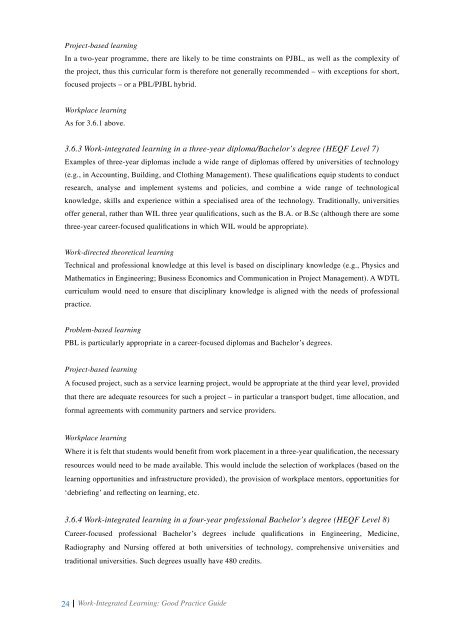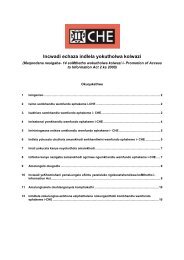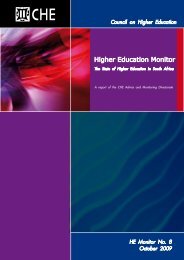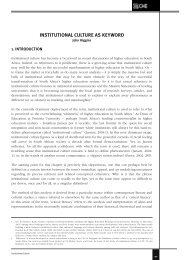Work-Integrated Learning: Good Practice Guide - CHE
Work-Integrated Learning: Good Practice Guide - CHE
Work-Integrated Learning: Good Practice Guide - CHE
You also want an ePaper? Increase the reach of your titles
YUMPU automatically turns print PDFs into web optimized ePapers that Google loves.
Project-based learning<br />
In a two-year programme, there are likely to be time constraints on PJBL, as well as the complexity of<br />
the project, thus this curricular form is therefore not generally recommended – with exceptions for short,<br />
focused projects – or a PBL/PJBL hybrid.<br />
<strong>Work</strong>place learning<br />
As for 3.6.1 above.<br />
3.6.3 <strong>Work</strong>-integrated learning in a three-year diploma/Bachelor’s degree (HEQF Level 7)<br />
Examples of three-year diplomas include a wide range of diplomas offered by universities of technology<br />
(e.g., in Accounting, Building, and clothing Management). these qualifications equip students to conduct<br />
research, analyse and implement systems and policies, and combine a wide range of technological<br />
knowledge, skills and experience within a specialised area of the technology. traditionally, universities<br />
offer general, rather than WIL three year qualifications, such as the B.A. or B.Sc (although there are some<br />
three-year career-focused qualifications in which WIL would be appropriate).<br />
<strong>Work</strong>-directed theoretical learning<br />
technical and professional knowledge at this level is based on disciplinary knowledge (e.g., Physics and<br />
Mathematics in Engineering; Business Economics and communication in Project Management). A WdtL<br />
curriculum would need to ensure that disciplinary knowledge is aligned with the needs of professional<br />
practice.<br />
Problem-based learning<br />
PBL is particularly appropriate in a career-focused diplomas and Bachelor’s degrees.<br />
Project-based learning<br />
A focused project, such as a service learning project, would be appropriate at the third year level, provided<br />
that there are adequate resources for such a project – in particular a transport budget, time allocation, and<br />
formal agreements with community partners and service providers.<br />
<strong>Work</strong>place learning<br />
Where it is felt that students would benefit from work placement in a three-year qualification, the necessary<br />
resources would need to be made available. this would include the selection of workplaces (based on the<br />
learning opportunities and infrastructure provided), the provision of workplace mentors, opportunities for<br />
‘debriefing’ and reflecting on learning, etc.<br />
3.6.4 <strong>Work</strong>-integrated learning in a four-year professional Bachelor’s degree (HEQF Level 8)<br />
career-focused professional Bachelor’s degrees include qualifications in Engineering, Medicine,<br />
radiography and Nursing offered at both universities of technology, comprehensive universities and<br />
traditional universities. Such degrees usually have 480 credits.<br />
24<br />
<strong>Work</strong>-<strong>Integrated</strong> <strong>Learning</strong>: <strong>Good</strong> <strong>Practice</strong> <strong>Guide</strong>






